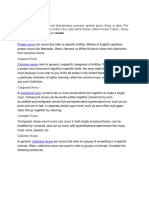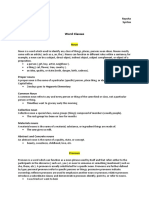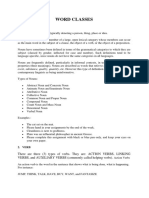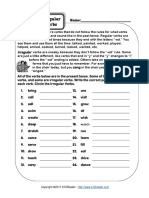What Is Noun?
What Is Noun?
Uploaded by
Christian GarciaCopyright:
Available Formats
What Is Noun?
What Is Noun?
Uploaded by
Christian GarciaOriginal Description:
Original Title
Copyright
Available Formats
Share this document
Did you find this document useful?
Is this content inappropriate?
Copyright:
Available Formats
What Is Noun?
What Is Noun?
Uploaded by
Christian GarciaCopyright:
Available Formats
Christian Ray M.
Garcia
BSHM-4
English A
What is Noun?
- A word (other than a pronoun) used to identify any of a class of people, places, or things
(common noun), or to name a particular one of these (proper noun).
Types of Nouns
Common nouns refer to general, unspecific categories.
Proper nouns are nouns that refer to specific people, places or things.
Concrete nouns are nouns that refer to things that exist physically and can be touched,
seen, smelled, felt, or tasted.
Abstract nouns to refer to them. Ideas, qualities or conditions like love, hate, power, and
time.
Collective nouns are nouns that refer to a group of something in particular. Often,
collective nouns are used to refer to groups of animals
A compound noun contains two or more words that join together to make a single noun.
Compound nouns can be two words written as one (closed form).
Countable nouns can occur in both single and plural forms, can be modified by numbers,
and can co-occur with quantifying determiners, such as many, most, more, several, etc.
Uncountable noun, you'll see them referred to as uncountable, non-countable or mass
nouns. For example, the word "clutter" is an uncountable noun.
Material nouns refer to materials or substances from which things are made.
Possessive nouns demonstrate ownership over something else. The best way to spot
them is to look for an apostrophe.
What is Pronoun?
A word that can function by itself as a noun phrase and that refers either to the
participants in the discourse (e.g., I, you) or to someone or something mentioned
elsewhere in the discourse (e.g., she, it, this).
Types of Pronoun
Demonstrative pronouns are used to demonstrate or
indicate. This, that, these and those are all demonstrative pronouns.
Indefinite pronouns, which point out specific items, indefinite pronouns are used for non-
specific things. This is the largest group of pronouns. All, some, any, several, anyone,
nobody, each, both, few, either, none, one and no one are the most common.
Interrogative pronouns are used in questions. Although they are classified as pronouns,
it is not easy to see how they replace nouns. Who, which, what, where and how are all
interrogative pronouns
Personal pronouns are I, you, he, she, it, we, they, and who. More often than not (but not
exclusively), they replace nouns representing people.
Possessive pronouns are used to show possession. As they are used as adjectives, they
are also known as possessive adjectives. My, your, his, her, its, our and there are all
possessive pronouns
Relative pronouns are used to add more information to a sentence. Which, that, who
(including whom and whose) and where are all relative pronouns
What is Verb?
Verbs are the action words in a sentence that describe what the subject is doing. Along
with nouns, verbs are the main part of a sentence or phrase, telling a story about what is
taking place.
Types of Verbs
Action verbs are words that express action (give, eat, walk, etc.) or possession
(have, own, etc.). Action verbs can be either transitive or intransitive.
A transitive verb always has a noun that receives the action of the verb, called the
direct object.
An intransitive verb never has a direct or indirect object. Although an intransitive verb
may be followed by an adverb or adverbial phrase, there is no object to receive its
action.
A linking verb connects the subject of a sentence to a noun or adjective that renames
or describes the subject. This noun or adjective is called the subject complement.
Helping verbs are used before action or linking verbs to convey additional
information regarding aspects of possibility (can, could, etc.) or time (was, did, has,
etc.). The main verb with its accompanying helping verb is called a verb phrase.
What is Adjective?
A word or phrase naming an attribute, added to or grammatically related to a noun to
modify or describe it.
Types of Adjective
Coordinate adjectives are small groups of adjectives that band together to modify the
same noun. They're separated by the word "and" or with commas.
Demonstrative adjectives point to "which" noun or pronoun you're speaking about.
Descriptive adjectives. They're generally what we envision when we imagine a word
modifying a noun they give the noun a quality or attribute.
Distributive adjectives point out specific entities. They single out a particular noun or
pronoun in order to modify, or draw attention, to it.
Indefinite adjectives. Similar to indefinite articles, these adjectives point to non-specific
items.
Interrogative adjectives pose a question. They need a noun or pronoun by their side.
Proper adjectives are capitalized adjectives derived from proper nouns. A proper noun is
a specific name for a person, place, or thing.
Quantitative adjectives describe the quantity of something.
Sequence adjectives are akin to quantitative adjectives.
What is Adverb?
A word or phrase that modifies or qualifies an adjective, verb, or other adverb or a word
group, expressing a relation of place, time, circumstance, manner, cause, degree, etc.
(e.g., gently, quite, then, there).
Types of Adverb
An adverb of time provides more information about when a verb takes place. Adverbs of
time are usually placed at the beginning or end of a sentence. When it is of particular
importance to express the moment something happened we’ll put it at the start of a
sentence.
Adverbs of place illustrate where the verb is happening. It’s usually placed after the main
verb or object, or at the end of the sentence.
Adverbs of manner provide more information about how a verb is done. Adverbs of
manner are probably the most common of all adverbs. They’re easy to spot too. Most of
them will end in –ly.
Adverbs of degree explain the level or intensity of a verb, adjective, or even another
adverb.
Adverbs of frequency explain how often the verb occurs. They’re often placed directly
before the main verb of a sentence.
A conjunctive adverb is a type of adverb that joins two independent sentences or
clauses of any kind. This type of adverb is used to connect two parts into one longer
sentence.
You might also like
- Introducing Arabic PDFDocument151 pagesIntroducing Arabic PDFMohamed Pauzi100% (1)
- Planif ENGLEZA 5 Art Klett 2023-2024Document6 pagesPlanif ENGLEZA 5 Art Klett 2023-2024Diana FilipNo ratings yet
- ҮГЗҮЙ 3. ГЭРИЙН ДААЛГАВАРDocument8 pagesҮГЗҮЙ 3. ГЭРИЙН ДААЛГАВАРLi QiangNo ratings yet
- Introducing The Eight Parts of SpeechDocument2 pagesIntroducing The Eight Parts of SpeechSara TorelliNo ratings yet
- Parts of SpeechDocument9 pagesParts of SpeechJose BrabanteNo ratings yet
- Parts of SpeechDocument7 pagesParts of SpeechBhavna SinghalNo ratings yet
- PronounsDocument8 pagesPronounsJucelmo Adriano Luis LuisNo ratings yet
- Raysha's SyntaxDocument5 pagesRaysha's SyntaxM. Fauzi ArrasyidNo ratings yet
- Topic 1 Grm. Parts of SpeechDocument17 pagesTopic 1 Grm. Parts of SpeechHafizNo ratings yet
- Purposive Communication.Document8 pagesPurposive Communication.Kyla Ramos Diamsay100% (1)
- Grammar DefinitionsDocument11 pagesGrammar DefinitionsMaría VielmanNo ratings yet
- The Verb Is Perhaps The Most Important Part of The SentenceDocument2 pagesThe Verb Is Perhaps The Most Important Part of The SentencemahyoolNo ratings yet
- Presentation Parts of Speech 1456425302 129863Document10 pagesPresentation Parts of Speech 1456425302 129863harshilguptaNo ratings yet
- Crash Course - Final SyllabusDocument32 pagesCrash Course - Final SyllabusynrNo ratings yet
- Nouns Is A Word Used To Name A PersonDocument2 pagesNouns Is A Word Used To Name A PersonmonvingNo ratings yet
- Grammar For PPSCDocument22 pagesGrammar For PPSCAlina NoreenNo ratings yet
- Primary Grammar Glossary For ParentsDocument6 pagesPrimary Grammar Glossary For ParentsJack EdieNo ratings yet
- Parts of SpeechDocument19 pagesParts of Speechzafar iqbalNo ratings yet
- Parts of Speech The Building Blocks of LanguageDocument10 pagesParts of Speech The Building Blocks of LanguagetausifnaileNo ratings yet
- INGLES Actividad 1Document4 pagesINGLES Actividad 1Chiquinquira MorenoNo ratings yet
- Parts of Speech in EnglishDocument13 pagesParts of Speech in EnglishApparel ShopNo ratings yet
- JURNAL 2 - Paper WritingDocument6 pagesJURNAL 2 - Paper WritingRahmiatun KhasanahNo ratings yet
- Parts of SpeechDocument6 pagesParts of SpeechKenneth ReyesNo ratings yet
- The Simple Sentence: Parts of Speech Sentence AnalysisDocument7 pagesThe Simple Sentence: Parts of Speech Sentence AnalysismiriamacunaNo ratings yet
- PARTS OF SPEECH UpdatedDocument12 pagesPARTS OF SPEECH UpdatedMCC Gilgit-BaltistanNo ratings yet
- Possessive Pronouns and Adjectives: RD ND NDDocument4 pagesPossessive Pronouns and Adjectives: RD ND NDmarifeNo ratings yet
- Someone, Everybody, Etc.) Is A Word That Takes The Place of A NounDocument2 pagesSomeone, Everybody, Etc.) Is A Word That Takes The Place of A NounCt Fairuz HananiNo ratings yet
- Stucture Word ClassesDocument10 pagesStucture Word ClassesDwiNo ratings yet
- Eng Lang 1Document52 pagesEng Lang 1cringerNo ratings yet
- The Process of Sending and Receiving Messages Through Verbal or Nonverbal Means - (Oral (Written Communication),, Signals, or BehaviorDocument7 pagesThe Process of Sending and Receiving Messages Through Verbal or Nonverbal Means - (Oral (Written Communication),, Signals, or BehaviorAyaba RoselynNo ratings yet
- PDF Parts of SpeechDocument7 pagesPDF Parts of SpeechSuraj MallahNo ratings yet
- What Does It Mean To Know A WordDocument5 pagesWhat Does It Mean To Know A WordAlthea Mae GelacioNo ratings yet
- Guide - Words, Phrases, Clauses and SentencesDocument14 pagesGuide - Words, Phrases, Clauses and SentencesTomas G Salazar TNo ratings yet
- Structure of EnglishDocument9 pagesStructure of EnglishCherry Mae PalilioNo ratings yet
- Parts of SpeeachDocument6 pagesParts of SpeeachMuhammad AfzalNo ratings yet
- The 8 Parts of SpeechDocument6 pagesThe 8 Parts of SpeechGlycel Angela JacintoNo ratings yet
- Trabajo InglésDocument8 pagesTrabajo InglésGraciela GonzalezNo ratings yet
- Soe ReviewerDocument23 pagesSoe ReviewersymerdavedangoNo ratings yet
- The Parts of SpeechDocument4 pagesThe Parts of SpeechNarcysNo ratings yet
- Common Transitional Words and PhrasesDocument5 pagesCommon Transitional Words and PhrasesArianne Kate BorromeoNo ratings yet
- IELTS GRAMMAR (From Basic To Types)Document18 pagesIELTS GRAMMAR (From Basic To Types)Builoan1986No ratings yet
- WDocument2 pagesWhihiNo ratings yet
- Linguistic Group 4 Report Syntax 10-16-2024Document103 pagesLinguistic Group 4 Report Syntax 10-16-2024aaron johnNo ratings yet
- Bahasa Inggris Kamilatun Najihah 22610085Document4 pagesBahasa Inggris Kamilatun Najihah 22610085Maria Septiana Uto KeninNo ratings yet
- GrammaireDocument15 pagesGrammaireYun LaraNo ratings yet
- Mental VerbsDocument15 pagesMental VerbsHazel Ann Bragado CabacunganNo ratings yet
- Vrste Rijeci EngleskiDocument7 pagesVrste Rijeci EngleskiTarik AlicNo ratings yet
- English 10 Parts of Speech Flashcards - Quizlet PDFDocument6 pagesEnglish 10 Parts of Speech Flashcards - Quizlet PDFJustice Merville100% (1)
- Phrasal Verbs: DialogueDocument2 pagesPhrasal Verbs: DialogueRocio Ortega ButandaNo ratings yet
- Review Ee ErrrrDocument15 pagesReview Ee ErrrrJessica CasipitNo ratings yet
- Writing GuideDocument86 pagesWriting GuideSedra Mousa Al Samara mousa almokdad Almokdad al samara100% (1)
- Grammar GlossaryDocument12 pagesGrammar GlossaryJoacoo RodolicoNo ratings yet
- Parts of SpeechDocument12 pagesParts of SpeechKh adijaNo ratings yet
- 822 - Cir 253 Grade 10 Pcbo Reference MaterialDocument106 pages822 - Cir 253 Grade 10 Pcbo Reference MaterialPRANIT KANDASAMYNo ratings yet
- Word ClassDocument20 pagesWord Classa8781148No ratings yet
- Assmt Grammar HBET 2103Document16 pagesAssmt Grammar HBET 2103Wan Salmizan AzhaNo ratings yet
- 8 Parts of SpeechDocument5 pages8 Parts of SpeechMeliza ChocNo ratings yet
- Bahasa Inggris Maria Septiana U.K. 22610095Document4 pagesBahasa Inggris Maria Septiana U.K. 22610095Maria Septiana Uto KeninNo ratings yet
- Biru Hijau Imut Ceria Tugas Presentasi Kelompok - 20240317 - 230007 - 0000Document24 pagesBiru Hijau Imut Ceria Tugas Presentasi Kelompok - 20240317 - 230007 - 0000saputsaput251No ratings yet
- Grammar and Punctuation: The Parts of SpeechDocument2 pagesGrammar and Punctuation: The Parts of SpeechjonfoukNo ratings yet
- GrammarDocument6 pagesGrammarKHOR YI HUI MoeNo ratings yet
- The Term 'Simple Noun' Is Sometimes Used To Describe The Nouns Used To Make A Compound NounDocument5 pagesThe Term 'Simple Noun' Is Sometimes Used To Describe The Nouns Used To Make A Compound Nounferdinando16No ratings yet
- Connotative Words: Examples and Exercises: The Importance of ConnotationDocument5 pagesConnotative Words: Examples and Exercises: The Importance of ConnotationRanti Harvi100% (1)
- English MorphologyDocument19 pagesEnglish MorphologyStefanDribler998No ratings yet
- Hoobastank The ReasonDocument4 pagesHoobastank The ReasonAndrésZambranoNo ratings yet
- LEC Curs (1) (1Document29 pagesLEC Curs (1) (1Adelina CioacăNo ratings yet
- Verbals - ParticiplesDocument38 pagesVerbals - ParticiplesGinelyn MaralitNo ratings yet
- Intso Education: English Talent Search Olympiad (Etso) 2018 - 2019Document206 pagesIntso Education: English Talent Search Olympiad (Etso) 2018 - 201910C 27 SAI VISHWA JETHNo ratings yet
- SAT MathDocument35 pagesSAT MathAurora TarannumNo ratings yet
- The Quick and Dirty Guide To Japanese by Tad PerryDocument12 pagesThe Quick and Dirty Guide To Japanese by Tad PerryJeremias BenitezNo ratings yet
- CAE Exam-Infinitives and Gerunds 4 PagesDocument4 pagesCAE Exam-Infinitives and Gerunds 4 PagesisanlagNo ratings yet
- Irregular Verbs: Time SignalsDocument4 pagesIrregular Verbs: Time SignalsMawar Sani NainggolanNo ratings yet
- Unknown 2Document10 pagesUnknown 2Muthiah Raihana CoranaNo ratings yet
- Materi - Ajar Parts of SpeechDocument20 pagesMateri - Ajar Parts of SpeechAbdullah Anugra100% (1)
- Phrases and Clauses PDFDocument14 pagesPhrases and Clauses PDFTrisha Anne SyNo ratings yet
- Anam Hijab Word Formation ProcessDocument6 pagesAnam Hijab Word Formation ProcessAnam HijabNo ratings yet
- Introduction To Words and Morphemes: Dr. Leany Nani Harsa, M.SiDocument47 pagesIntroduction To Words and Morphemes: Dr. Leany Nani Harsa, M.Sidianto pwNo ratings yet
- A Complete Solution of EnglishDocument94 pagesA Complete Solution of Englishsarvesh kumar100% (1)
- Problems of Translating Auto-Antonymy From English Into ArabicDocument18 pagesProblems of Translating Auto-Antonymy From English Into ArabicEssam Tahir Muhammed AlkassabNo ratings yet
- Present Perfect: Task 1.-Regular VerbDocument3 pagesPresent Perfect: Task 1.-Regular VerbV̶̶̶̶̶̶̶̶̶̶͚̝̪͔̞̳͓a̶̶̻n̶̸̶̶̶̶̶̶̶̟͍͍͖͉ͅe̶̶̶̶͙̹͎g̶̶͈ạ̶̶̶̶̝̪s̶̶̶̶̶̶̶̶̙̩̲̮͉̥͞ Bv100% (1)
- Parts of SpeechDocument16 pagesParts of Speechmarta_harveyNo ratings yet
- Top Korean 100 Words PDF-1Document5 pagesTop Korean 100 Words PDF-1Luke FranciscoNo ratings yet
- Morphological Analyzer For TamilDocument37 pagesMorphological Analyzer For TamilArul DayanandNo ratings yet
- What Are Verbs?Document9 pagesWhat Are Verbs?Angeline Panaligan AnselaNo ratings yet
- Chapter 5. Lesson 3 Word Formation ProcessDocument5 pagesChapter 5. Lesson 3 Word Formation ProcessChavie MagallanesNo ratings yet
- Adverb PhrasesDocument5 pagesAdverb Phrasesthe GlitchNo ratings yet
- Regular and Irregular Verbs PDFDocument2 pagesRegular and Irregular Verbs PDFnove quimpo100% (1)
- Aulão 01 - Teacher Aline SerpaDocument7 pagesAulão 01 - Teacher Aline Serpalucianaassiscgmax5No ratings yet
- TNA 2999 Komplex Vizsga NyelveszetDocument2 pagesTNA 2999 Komplex Vizsga NyelveszetasdasdNo ratings yet

























































































